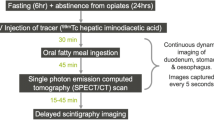Abstract
Conducting the qualitative evaluation of reconstruction methods is difficult because of their complexity. The aim of the present study was to compare esophageal bile and food reflux by performing gastrointestinal and hepatobiliary dual scintigraphy (GHDS) after various methods of reconstruction following total gastrectomy. Of 17 patients studied, 4 had undergone Roux-en-Y anastomoses (R-Y); 6, jejunal pouch-Y anastomoses (P-Y); and 7, jejunal pouch interposition (P-I). GHDS was performed 1 year after surgery using111In-diethylene triamine pentaacetic acid administered orally, and99mTc-pyridoxyl-5-methyl tryptophan administered intravenously. Imaging data from a gamma camera were stored in and processed by a data analyzer. Three patients who had undergone R-Y and one who had undergone P-I complained of heartburn, while one who had undergone R-Y, two who had undergone P-Y, and three who had undergone P-I complained of a feeling of fullness. Esophageal bile reflux was confirmed by GHDS in four of the patients who had undergone R-Y, one who had undergone P-Y, and four who had undergone P-I. Moreover, GHDS demonstrated food retention in two patients who had undergone R-Y, five who had undergone P-Y, and four who had undergone P-I. Weight loss was closely related to the esophageal reflux of bile or food which can be accurately detected by GHDS. Despite the absence of heartburn, patients diagnosed as having bile reflux by GHDS showed poor recovery of body weight.
Similar content being viewed by others
References
Ohuti K, Ono K, Shindo K (1967) Our ordinary reconstruction procedure (ϱ-amastomosis) after total gastrectomy (In Japanese). Geka (Surgery) 29:347–358
Troidl H, Kusche J, Vestweber KH, Eypasch E, Maul U (1987) Pouch versus esophagojejunostoy after total gastrectomy: a randomized clinical trial. World J Surg 11:699–712
Fisher RS, Malmud LS, Roberts GS, Lobis IF (1976) Gastroesophageal (GE) scintiscanning to detect and quantitate GE reflux. Gastroenterology 70:301–308
Fujiwara Y, Hashimoto N, Nakagawa K, Kusunoki T, Utsunomiya J (1993) Scintigraphic evaluation of gastroesophageal reflux following gastrectomy. Hepato-Gastroenterology 40:262–266
Aoki Y, Kakihara M, Sasaki M, Tabuse Y, Takei N, Taniguchi K, Katsumi M, Torizumi K (1981) Fundamental and clinical studies on simultaneous, quantitative analysis of hepatobiliary and gastrointestinal scintigrams using double isotope method (In Japanese). Nippon Shokaki Geka Gakkai Zasshi (Jpn J Gastroenterol Surg) 14:559–565
Inada T, Ogata Y, Ozawa I, Ohishi T, Takizawa I (1995) Evaluation of gastrointestinal function after gastrectomy by gastrointestinal and hepatobiliary dual scintigraphy and significance of vagal nerve preserving gastrectomy (in Japanese with English abstract). Nippon Shokaki Geka Gakkai Zasshi (Jpn J Gastroenterol Surg) 28:1641–1646
Sho M, Imagawa A, Hoshi T, Yamamoto M, Yagura M, Watanabe A, Nakano H (1996) Evaluation of reconstructive procedures follokwing total gastrectomy in the patients who lived more than 3 postoperative years—the comparison of Roux-en-Y and jejunal interposition (in Japanese with English abstract). Nippon Shokaki Geka Gakkai Zasshi (Jpn J Gastroenterol Surg) 29:2252–2257
Adachi S, Kawashima T, Ishikawa T, Ozaki A (1994) Usefulness of jejunal pouch reconstruction after total gastrectomy (in Japanese with English abstract). Nippon Shokaki Geka Gakkai Zasshi (Jpn J Gastroenterol Surg) 27:2093–2098
Nakane Y, Okumura S, Akehira K, Okamura S, Boku T, Okusa T, Tanaka K, Hioki K (1995) Jejunal pouch reconstruction after total gastrectomy for cancer. A randomized controlled trial. Ann Surg 222:27–35
Schwarz A, Büchler M, Usinger K, Rieger H, Glasbrenner B, Friess H, Kunz R, Beger HG (1996) Importance of the duodenal passage and pouch volume after total gastrectomy and reconstruction with the Ulm pouch: prospective randomized clinical study. World J Surg 20:60–67
Butters M, Bittner R, Schafmeyer A, Beger HG (1991) Release of pancreatic polypeptide and cholecystokinin after total gastrectomy: the effect of different reconstruction procedures. Eur J Gastroenterol Hepatol 3:29–33
Author information
Authors and Affiliations
Rights and permissions
About this article
Cite this article
Adachi, S., Takeda, T. & Fukao, K. Evaluation of esophageal bile reflux after total gastrectomy by gastrointestinal and hepatobiliary dual scintigraphy. Surg Today 29, 301–306 (1999). https://doi.org/10.1007/BF02483052
Received:
Accepted:
Issue Date:
DOI: https://doi.org/10.1007/BF02483052




